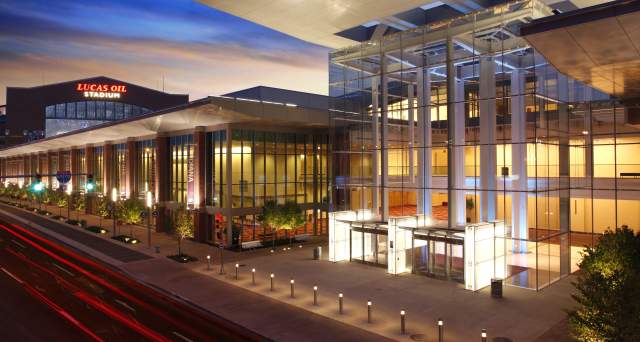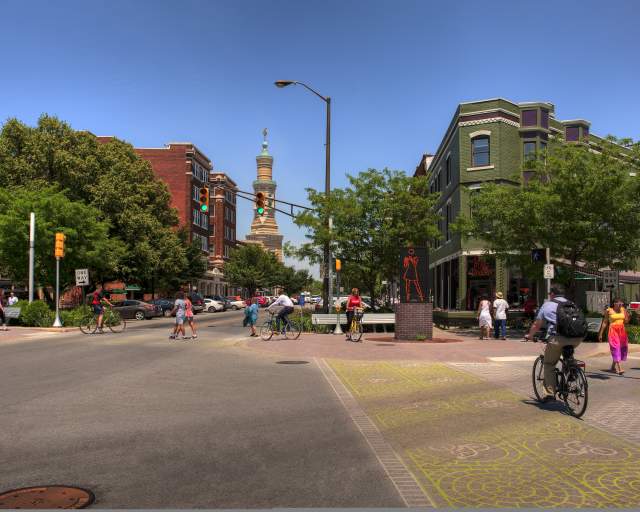Black History in Indy
The Madam Walker Legacy Center pays tribute to America's first female Black millionaire, Madam C.J. Walker.
Your browser is not supported for this experience.
We recommend using Chrome, Firefox, Edge, or Safari.

Sign up for trip ideas, opportunities to receive prize packs, and more!
Sign Up For Email

Sign up for trip ideas, opportunities to receive prize packs, and more!
Sign Up For Email
The Madam Walker Legacy Center pays tribute to America's first female Black millionaire, Madam C.J. Walker.
Indy's Black history is one of entrepreneurship and perseverance in times of hardship, one of creative expression, and one of fostering places of unity and forward-thinking despite adversity. From early black settlements of the 1820s, to stops in Indianapolis along the Underground Railroad, to cultural hubs that carry on the legacy today, African Americans have played an essential role in the growth of Indianapolis.
At the beginning of the 20th century, when entrepreneur and icon Madam C.J. Walker was looking for a city to grow her business of specialty, hair care products for African Americans, she looked no further than the Crossroads of America and set up shop in Indianapolis. Walker’s savvy business and leadership skills earned her status as the country’s first self-made female millionaire and transformed the beauty industry forever.
The legacy of Indy icon Marshall "Major" Taylor, the world's first Black sports superstar, is celebrated across the Circle City. Taylor was born and raised in Indianapolis before becoming the first Black world-champion professional cyclist. Major Taylor not only had success in cycling but also paved the way for minority athletes to be vocal about both racial and social justice.
In 1968, Robert F. Kennedy visited what is now Dr. Martin Luther King Jr. Park, initially to campaign, however instead had to deliver the news of Dr. King’s assassination. The Landmark for Peace Memorial was dedicated by former President Bill Clinton in 1995 to honor both Dr. King and the late Mr. Kennedy for their contributions to our nation. The park was then named for the famous civil rights leader and extends over 14 acres in Center Township of Indy.
Indiana Avenue is home to the Madam Walker Legacy Center, where Walker worked her way up to run an empire which made her one of the wealthiest, successful women in the 20th century. Beginning in 1821, Indiana Avenue was home to a popular jazz scene that lasted until the 1970s. At the height of its jazz era, “The Avenue” featured over 33 jazz clubs with headliners including Duke Ellington, Ella Fitzgerald, Nat King Cole, and more. Indiana Avenue also housed the first black-owned business in Indianapolis. In 1865, Samuel G. Smother opened a grocery store, and later in 1879 The Indianapolis Leader was the first African American-owned newspaper in Indy.
The Walker Manufacturing plant is now the Madam Walker Legacy Center which commemorates her zeal and drive for success.
Formerly the home of the Bethel A.M.E Church, this historic church building is now part of the new Hampton Inn/Homewood Suites on the Canal downtown
Just 30 miles north of Indianapolis stand the remains of an African American pioneer farm settlement founded in 1835 by free blacks of mixed racial heritage who migrated from the South. The pioneers pursued economic, educational, and religious aspirations with greater freedom and fewer racial barriers, goals which were achieved through hard work and assisted by racially tolerant Quaker and Wesleyan neighbors. Today, a chapel and cemetery are the physical reminders of a once thriving community.
Established in 1897, Ransom Place is the oldest African-American neighborhood in Indianapolis. The neighborhood originally consisted of four dozen homes on six city blocks and inspired the founding of the National Association for African-American Heritage Preservation. Ransom Place was named after Freeman B. Ransom, an attorney and general manager for the Walker Manufacturing Company.
Indianapolis offers a compelling journey through the impactful contributions of Black individuals to the city's and nation's history and culture. Immerse yourself in these exhibits and museums that weave together narratives of resilience, achievement, and the ongoing pursuit of equality.
This collection was gifted as a teaching collection to coincide with classes offered in the Art History Department. Consisting of various objects including materials made from wood, iron, ivory, clay, and brass, many pieces had ceremonial uses and relate to other activities which define the traditional, historical, and cultural aspects of West African life. Today, 32 African objects remain in Butler University’s collection.
From the Civil War and Indiana’s role on the Underground Railroad, to the legacies of Madam Walker and others, explore Indiana’s rich history via…
See bravery through the eyes of Ruby Bridges, the first grader who attended the newly desegregated schools of New Orleans in 1960. The largest…
Immerse yourself in the many ways African culture influenced what’s known today as “American” culture. Have an unforgettable personal encounter with…
A new initiative of the Indianapolis Public Library celebrates the literary and cultural contributions of African Americans in Indy and elsewhere…
Explore Indy's vibrant street art scene featuring larger-than-life murals paying homage to notable historical Black figures. Wander through neighborhoods like Mass Ave and Indiana Avenue, where these striking artworks tell powerful stories of resilience and achievement.
Several cultural and community partners worked together to complete a mural honoring Indianapolis-based poet and artist, Mari Evans — one of the…
Indianapolis-associated jazz legends of the 1950s and 1960s–(l to r) David Young, Jimmy Coe, David Baker, JJ Johnson, Slide Hampton, Freddie Hubbard…
Indianapolis recently added another mural to its abundant downtown collection, paying special tribute to Hoosier sports legend and racial justice…
The legacy of the Indianapolis entrepreneurial icon, Madam C.J. Walker, is alive here in Indy in so many ways. From the Madam Walker Legacy Center…